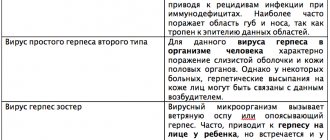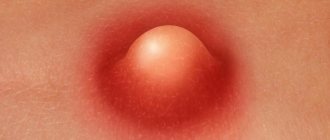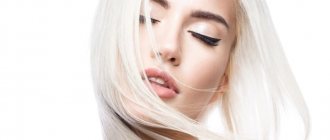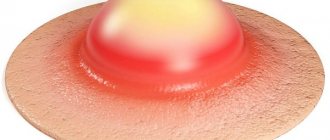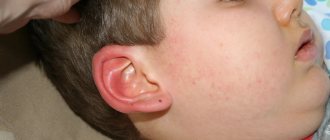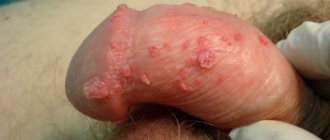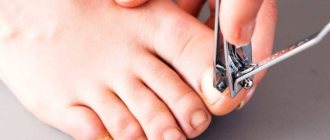Molluscs on the face - what are they?
Molluscs on the face (photo below) or molluscum contagiosum are nothing more than dermatosis of infectious etiology. The causative agent of the pathology is a virus that is part of the Smallpox family.
Molluscum manifests itself as small papules on the skin (mainly facial), filled with a white mushy substance and with a depression in the center.
Mollusks can appear on the face of a child or an adult, which is due to the method of transmission of the disease – contact.
In adults, sexual infection is also added. The disease resolves itself on its own within a maximum of a year and treatment is not required in all cases.
This does not pose any particular danger to human health, so there is no need to panic. However, it creates unpleasant sensations and moral discomfort. For this reason, people are unable to wait until this scourge goes away on its own, and immediately begin treatment.
Symptoms of molluscum contagiosum on the penis
From the moment of infection to the appearance of the first signs of infection, it takes from 2 to 25 weeks. At the end of the incubation period, dense small nodules are formed in the area of the skin where the pathogen has penetrated - up to three millimeters in diameter. They tend to increase up to 1 cm within 3-6 months. The pathology can be leveled out on its own without drug treatment.
After recovery, lifelong resistance to the virus develops. Secondary infection is observed only in exceptional situations against the background of provoking factors: a sharp decrease in immunity, severe chronic diseases. If the nodules do not disappear on their own, then self-infection cannot be ruled out. In this case, the appearance of new tumors is observed.
It’s worth knowing: molluscum contagiosum is not a dangerous pathology; it tends to go away on its own when the immune system suppresses the activity of the virus. Dense nodules, as a rule, do not bother the patient - there is no itching, burning, or pain. For the most part, they are a cosmetic problem that causes psychological discomfort.
The dominant symptom is growths on the penis. They appear gradually and grow slowly. On average, 5-15 nodules are diagnosed per patient. In some situations their number amounts to tens (rarely). At first they are small in size, but within 3-6 months they increase to 3-10 mm. Individual elements grow up to 15 mm.
Against the background of molluscum contagiosum, all rashes on the penis are of different sizes, but have the same appearance. When neoplasms develop close to each other, they merge into large surfaces up to 4-5 centimeters. Such formations are susceptible to inflammation and can fester, which leads to the formation of crusts and ulcerative skin lesions.
Features of rashes on the penis with molluscum contagiosum:
- Regardless of the stage of the disease, blisters always protrude above the skin;
- The edges are smooth, the consistency is dense;
- The shade is pearlescent or pink;
- There is a small depression in the center of the nodule;
- If you press on the nodule, it contains epithelial cells and particles of the pathogen;
- The skin around the tumors does not change.
These symptoms describe the classic picture of molluscum contagiosum on the penis. In medical practice, there is a giant form - one nodule appears, but of a large size - from 20 cm. They also distinguish the pedicular form - large nodes are formed by the merging of small rashes. There are other types of the disease, but they do not affect the genital area.
Possible causes of the disease
Molluscum contagiosum has a wide distribution area. Its development is not particularly influenced by external factors - climate, social conditions, age.
The reasons for the spread of pathology are the following:
- Failure to comply with basic hygiene rules - personal and general.
- Rare and poor-quality cleaning of residential premises.
- Decreased immune capabilities of the body.
The following categories of citizens are at risk of being affected by molluscs:
- with weak immunity;
- HIV infected;
- cancer patients;
- susceptible to allergies;
- those suffering from rheumatoid arthritis;
- taking cytostatics and hormonal drugs.
Also at constant risk are those whose line of work involves frequent contact with the epidermis of other people: massage therapists, doctors, bathhouse attendants, nurses, sports trainers and others.
If the disease is caused by a weakened immune system, then it is advisable not to wait for self-healing, but to take appropriate measures to improve health.
Otherwise, the infection may become chronic. And also against the background of poor health, there is a high risk of other, more dangerous infections.
Symptoms (3 forms of the disease)
Diagnosed mollusks on the face of a child and an adult undergo an initial incubation period lasting from 2 weeks to six months. Only after this the first symptoms appear.
When the virus penetrates deep into the layers of the dermis, a favorable environment is created for the reproduction of other parasites and intracellular spread.
Molluscs on the face (as in the photo) in adults and children are rounded nodules (papules) of pinkish-yellow color with a smooth surface. They are localized mainly on the eyelids and eyebrows.
Due to the intensive reproduction of pathogens, the rash spreads quite close.
When you press on the formations from the inside, a thick, cheesy component is released.
According to the clinical picture of molluscum contagiosum, 3 forms of development are distinguished:
- Typical - single rashes and on a specific area of the epidermis.
- Generalized – there are quite a lot of papules, located relatively far from each other. They begin to spread throughout the body.
- Complicated - inflammatory processes with purulent discharge from the skin near the tumors are observed (a stage inherent in HIV-infected patients).
Mollusks on a child’s face often take on an unusual shape – profuse. With it, the bubbles do not have a concavity, and they are small in size.
A similar course of the disease is typical for children suffering from leukemia, HIV infection, atopic dermatitis or immunodeficiency.
Diagnosis
The diagnosis is made by a doctor after a thorough examination and study of the general clinical picture of the patient. In case of controversial nuances, a histological examination of the contents of pimples is prescribed. It is studied under a microscope to detect mollusc-like bodies.
External symptoms of molluscum contagiosum are identical to many other diseases:
- lichen planus;
- syphilis;
- warts;
- chicken pox;
- allergic rashes;
- tumors.
For an accurate diagnosis, you need to consult a dermavenerologist.
Diagnosis of molluscum contagiosum
The disease is difficult to identify on your own, since the nodules on the skin resemble ordinary pimples.
If the rash is isolated, adults most often do not pay attention to these signs and believe that they will go away on their own. The SM-Doctor clinic employs only experienced doctors, who will not have any difficulty making the correct diagnosis at the first appointment.
To confirm the diagnosis, a skin scraping is taken and the material is examined under a microscope. When infected with a virus, mollusc bodies are visible in the cytoplasm of cells.
A diagnosis of molluscum contagiosum does not mean that a child has serious health problems. It is necessary to treat not only the skin, but also strengthen the immune system so that the body can cope with the pathogen itself.
How to be treated
Only the doctor explains how to treat molluscs on the face after making a diagnosis. Typically, specialists do not resort to drug therapy if the body as a whole is strong and the immune system is in order.
Over time, all symptoms gradually disappear. If immunity is reduced, then without taking certain measures there is a high probability of transformation of the initial stage into a chronic one.
If the body is extremely weakened due to any diseases or for other reasons, it is vitally important to constantly take measures to strengthen the immune system.
In such a situation, medications are prescribed depending on a number of indications: the patient’s age, general well-being, and the stage of the disease.
List of commonly prescribed medications:
- Cycloferon.
- Amexin.
- Antibiotics: Metacycline, Tetracycline.
For external treatment of the affected areas, ointments are used - oxolinic, Acyclovir.
Treatment
Doctors are still arguing whether it is necessary to treat molluscs on the penis or not. Opponents of drug therapy argue that pathology does not pose any danger to the patient, neoplasms can disappear on their own, and self-healing contributes to the development of immunity for life.
But on the other hand, pathological elements on the penis are a cosmetic defect that has an unaesthetic appearance. This circumstance often leads to psychological disorders and complexes, which leads to problems in intimate life.
Fact: when the nodules are localized on the penis, in the anus area, it is better to remove them without waiting for them to disappear on their own. This is due to the fact that the location of the tumors leads to trauma during defecation and sex, which provokes infection of the partner and the spread of infection to other areas of the skin.
Therapy for molluscum contagiosum on the genital organ is carried out in different ways: medications are prescribed, mechanical excision (removal) of pathological neoplasms. You can use folk remedies.
Treatment with medications
Drug therapy involves the use of medications, the chemical formula of which includes substances that promote the destruction and subsequent death of nodules on the skin. Use topical agents - solutions, creams, ointments.
It is advisable to use the following medications:
- Venasoid. Dosage form – ointment. The medication is applied pointwise to the nodules twice a day, left for six hours, then washed off with running water. Treatment lasts until the tumors completely disappear.
- Trichloroacetic acid 3%. The solution is applied to the affected area using a pipette. Each nodule is treated once a day. 30 minutes after the manipulation, the solution is washed off with plain water.
- Vartek - cream. Apply twice a day.
- Acyclovir is an antiviral drug. Apply to the skin three times a day.
The medications described above are the medications of choice. In most cases, when molluscum contagiosum is localized on the penis, mechanical removal is recommended. This is based on the fact that ointments/creams can injure the delicate skin of the penis, which leads to pain and inflammation.
Removal in the clinic
To completely get rid of pathological elements on the skin of the penis, mechanical removal is recommended. The manipulation is accompanied by painful sensations, so anesthesia is required. It is best to use Emla cream. Lidocaine and other similar drugs are characterized by low effectiveness.
Laser removal is most often used. During the procedure, each tumor is irradiated with a laser, after which the surface is treated with an iodine solution. If 7 days after the manipulation the nodules have not fallen off, repeated exposure is required.
For your information, with the help of laser therapy it is possible to destroy 90-93% of nodules after the first manipulation. After the crusts fall off, there are no scars left.
Methods for removing molluscum contagiosum on the penis:
- Exposure to liquid nitrogen. After such removal, scars and scars may remain, skin pigmentation;
- Electrocoagulation - rashes are cauterized with electric current.
Removal by curettage and husking. During the manipulation, the contents of the nodules are scraped out or removed with special tweezers. The manipulation is unpleasant and painful, and there may be slight bleeding after removal. After the procedure, sunken scars often form.
Folk remedies
To remove pathological elements in the intimate area, you can use traditional medicine. They are prepared independently using medicinal herbs. The most effective method is a garlic compress. Grind fresh garlic into a pulp and mix with butter in equal proportions. The finished mixture is applied to the tumors and then fixed with an adhesive plaster.
Applications are made up to three times a day. The duration of treatment is until the elements on the skin completely disappear. If the mixture gets on healthy skin, there is a high probability of burns followed by the formation of redness and other negative consequences.
Treatment with folk remedies:
- Rub the nodules with garlic juice up to 7 times a day.
- Tincture based on string. To prepare the “medicine” you need to pour two tablespoons of the herb into 250 ml of boiling water and bring to a boil. Leave for 4 hours in a dark place. The tincture is used to wipe molluscum contagiosum 3-5 times a day.
- Alcohol infusion with calendula. Add 2 tablespoons of plant inflorescences to 200 ml of alcohol and leave for a week. Wipe the affected area with the solution 3 times a day.
Bird cherry juice helps destroy tumors. It is necessary to wash fresh leaves and pass through a meat grinder. Then the pulp is mixed with butter and applied to the nodules, secured on top with a plaster and bandage. Leave it overnight.
Question answer
Most often, preschool children, adolescents and elderly people (after 60 years) become ill with molluscum contagiosum.
The surprising thing is that babies under one year of age never get sick with this, and this is due to the presence in the body of special antibodies that come from breast milk and are partially transferred from the mother's placenta. Papules can appear singly or in groups, gradually merging together.
Such neoplasms on the face do not cause pain, but sometimes itching may occur. Inflammation progresses only if another infection occurs.
TOP 5 methods for removing formations
There is more than one technique that allows you to get rid of this problem in a short period. Let's look at them in more detail.
Laser exposure
Under the influence of a laser beam, the skin with molluscum rashes overheats, which helps to destroy the causative viruses. Damaged cells also evaporate.
The laser penetration depth into the skin layers is no more than 5 mm, which cannot cause harm to the tissues in the vicinity.
The procedure is absolutely safe for both children and adults. Does not cause any discomfort or pain. It is carried out in sterility and prevents further spread of the virus.
After you have managed to get rid of molluscs on your face, you should protect the treated areas for the first 3 days. You cannot go to the pool or sauna, or sunbathe for a long time in the sun or in a solarium.
Using liquid nitrogen
You can get rid of such a scourge as mollusks on the face with the help of chilled liquid nitrogen.
By freezing the contents of the papules, the process is inhibited. Against this background, damaged tissues disintegrate.
This procedure is safe and painless, keeps nearby healthy cells intact and does not leave scars.
Thus, it is recommended to remove shellfish from the child’s face. The treatment is effective, and most importantly, one-time. In the future, there is no need to take any medications.
Electrocoagulation method
Molluscum contagiosum is destroyed by exposure to a special coagulator spray with the simultaneous influence of variable frequency currents. This destroys pathological bodies and affected dermal cells.
Local anesthesia is used to relieve the pain threshold. Upon completion of the procedure, crusts remain on the treated areas, which quickly heal without a trace.
Surgical scraping of papules
If there are few bubbles, then surgical curettage is prescribed. Approximately an hour before surgery, the area with papules is lubricated with an anesthetic cream.
Then a sterile bandage is applied on top, which is removed immediately before the operation. The skin is wiped and the procedure begins.
To scrape the papules, a special tool is used - a curette or a wooden spatula pointed at the end. Sometimes tweezers are used.
When all contents have been removed, the skin is treated with iodine. During the process, bleeding is possible, which subsequently leads to scarring.
Getting rid of papules with chemicals
The method is simple to implement, but quite productive. It involves daily application of ointments and solutions with an antiviral spectrum of action to the nodular rash:
- Fluorouracil or Oxolinic ointment;
- Gels containing benzoyl peroxide;
- Tretinoin;
- Imiquimod;
- Infagel;
- Vartek;
- Kondilin;
- trichloroacetic acid solution;
- salicylic acid.
It is enough to do this twice a day. Complete cure occurs in 4-10 weeks.
The products are applied point-by-point - exclusively to the neoplasms themselves. At the same time, they try not to affect living tissue.
Treatment of molluscum contagiosum
If in adults with strong immunity the disease cannot be treated, then children need a course of therapy. After consulting a pediatrician, the child should visit a dermatologist. How to treat molluscum contagiosum in children depends on the choice of the doctor:
- You can remove the contents of “pimples” with tweezers and a sharp spoon. After the procedure, the affected areas are lubricated with iodine.
- You can cauterize with a laser or electric current. This method of removing the pathogen is called diathermocoagulation.
- You can cauterize the rash with dry ice or liquid nitrogen.
If the rash occupies large areas of the body, systemic therapy is indicated - immunostimulating medications and antibiotics.
Children under 10 years of age are prescribed only immunomodulators, since tetracycline antibiotics are contraindicated for them. It is impossible to completely get rid of the virus due to the structural features and functioning of the microorganism. Medicines can only strengthen the immune system and quickly remove external signs of the disease. Microorganisms remain in the human body for life. To avoid future relapses, you need to monitor your health, eat well, and strengthen your immune system. Parents need to teach their child hygiene and a healthy lifestyle.
Important! You cannot treat molluscum with folk remedies: herbs, cauterization. Such measures only increase the affected area on the skin. It is better to consult a doctor and get traditional treatment with proven effectiveness.
Folk remedies for fighting shellfish (4 recipes)
Treatment of molluscum on the face with folk remedies is possible in different ways, for which there are many effective recipes. They include both individually and in combination herbal and medicinal products.
The most promising options are presented in the table:
| An approach | Photo | Instructions |
| Garlic | Grind the garlic to a paste and mix with softened butter. The proportions are maintained at 1:1. Distribute the mass over gauze and apply it to the papules, fixing it with an adhesive plaster. Change the lotions to fresh ones three times a day. You can wipe the affected areas with garlic alone (cut into a clove). The course of treatment is a week. | |
| Potassium permangantsovka | Cauterization is carried out with a manganese solution. | |
| Iodine, hydrogen peroxide, calendula tincture | Apply any product directly to the tumors with a cotton swab, being careful not to infect healthy skin. Medical alcohol is applied around the papules. Then the nodules are carefully squeezed out and treated with alcohol. Cauterize with iodine, hydrogen peroxide or calendula. It is advisable to wash clothes and bedding to prevent re-infection. After the procedure, you should not wet the wounds and carry out disinfection with iodine every day. As soon as crusts appear, use oxolinic ointment. | |
| Celandine juice | Lubricate the rash with freshly squeezed juice of celandine or dandelions. Eucalyptus also helps a lot. |
How to behave during the recovery period
During treatment, it is recommended to protect the child from contact with other people. A visit to kindergarten is postponed until complete recovery, so as not to infect other children.
All things that the child uses are constantly washed and disinfected. The apartment must undergo a general wet cleaning. This will minimize the spread of infection through dust, in which it is well preserved.
You cannot take a bath, visit the swimming pool, sauna or bathhouse. Parents should monitor the baby, preventing him from scratching the affected parts of the body. The little patient is required to maintain personal hygiene.
For adult patients, it is advisable to cover the pustules with adhesive tape to create protection for a healthy environment. It is not recommended to shave the hair on the skin in the lesions.
To prevent cracking of the epidermis and the formation of inflammation, you need to apply the cream daily. Since the infection is also transmitted sexually, close sexual contact with casual partners should be avoided.
Molluscum contagiosum itself is not dangerous and is not prone to progression. Even in the absence of any therapeutic intervention, it goes away on its own.
But a different outcome is possible if you vigorously scratch the nodular rashes. Then pathogenic bacteria penetrate the wounds and initiate the inflammatory process.
The symptoms of its onset are as follows: swelling, redness, purulent discharge. Ignoring such a picture leads to the activation of dermatitis.
It will have to be treated for a long time and gruelingly, which will ultimately lead to cosmetic defects on the face.
Prevention
To prevent this disease, you should follow these useful tips:
- monitor the state of the child’s immune system;
- Healthy food;
- adhere to the rules of personal hygiene;
- avoid contact with sick children;
- treat any infectious diseases in a timely manner;
- Regularly undergo medical examinations with a pediatrician.
Molluscum contagiosum is not life-threatening for a child, but this disease can cause a lot of inconvenience for a long time. Parents should pay a lot of attention to the hygiene of their son or daughter - often change bed linen and clothes, as well as wash them at high temperatures, iron things, disinfect various household items and toys. If a child is diagnosed with an illness, be sure to inform the caregiver or teacher about it.
Opisthorchiasis Stomatitis in children: photos, symptoms and treatment Seborrheic dermatitis Lichen planus How to quickly get rid of lice and nits at home Sunburn
Expert opinion
- Cosmetologist
- Surgeon
Michelle Ellern
practicing cosmetologist-dermatologist
Do not scratch papules on the face, as this will lead to the spread of infection to other parts of the body. In men, infection often occurs during shaving, as a result of which nodules migrate to the chin and cheeks.
Theda Contis
plastic surgeon
During the recovery period (4–18 months), it is necessary to strengthen the immune system, harden, eat a balanced and nutritious diet, including fresh fruits and vegetables in the diet. It would be a good idea to play sports and often take walks in the fresh air. A periodic stay in a pine forest will be especially useful.
Whether to remove mollusks on the face is up to each person to decide for themselves. One thing is certain: these formations spoil the appearance and add complexities. This is why many doctors advise not to wait until the problem goes away on its own.
